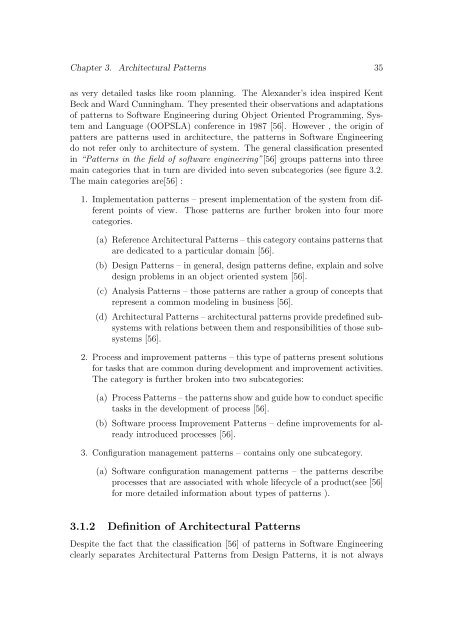Migration of a Chosen Architectural Pattern to Service Oriented ...
Migration of a Chosen Architectural Pattern to Service Oriented ...
Migration of a Chosen Architectural Pattern to Service Oriented ...
Create successful ePaper yourself
Turn your PDF publications into a flip-book with our unique Google optimized e-Paper software.
Chapter 3. <strong>Architectural</strong> <strong>Pattern</strong>s 35as very detailed tasks like room planning. The Alexander’s idea inspired KentBeck and Ward Cunningham. They presented their observations and adaptations<strong>of</strong> patterns <strong>to</strong> S<strong>of</strong>tware Engineering during Object <strong>Oriented</strong> Programming, Systemand Language (OOPSLA) conference in 1987 [56]. However , the origin <strong>of</strong>patters are patterns used in architecture, the patterns in S<strong>of</strong>tware Engineeringdo not refer only <strong>to</strong> architecture <strong>of</strong> system. The general classification presentedin “<strong>Pattern</strong>s in the field <strong>of</strong> s<strong>of</strong>tware engineering”[56] groups patterns in<strong>to</strong> threemain categories that in turn are divided in<strong>to</strong> seven subcategories (see figure 3.2.The main categories are[56] :1. Implementation patterns – present implementation <strong>of</strong> the system from differentpoints <strong>of</strong> view. Those patterns are further broken in<strong>to</strong> four morecategories.(a) Reference <strong>Architectural</strong> <strong>Pattern</strong>s – this category contains patterns thatare dedicated <strong>to</strong> a particular domain [56].(b) Design <strong>Pattern</strong>s – in general, design patterns define, explain and solvedesign problems in an object oriented system [56].(c) Analysis <strong>Pattern</strong>s – those patterns are rather a group <strong>of</strong> concepts thatrepresent a common modeling in business [56].(d) <strong>Architectural</strong> <strong>Pattern</strong>s – architectural patterns provide predefined subsystemswith relations between them and responsibilities <strong>of</strong> those subsystems[56].2. Process and improvement patterns – this type <strong>of</strong> patterns present solutionsfor tasks that are common during development and improvement activities.The category is further broken in<strong>to</strong> two subcategories:(a) Process <strong>Pattern</strong>s – the patterns show and guide how <strong>to</strong> conduct specifictasks in the development <strong>of</strong> process [56].(b) S<strong>of</strong>tware process Improvement <strong>Pattern</strong>s – define improvements for alreadyintroduced processes [56].3. Configuration management patterns – contains only one subcategory.(a) S<strong>of</strong>tware configuration management patterns – the patterns describeprocesses that are associated with whole lifecycle <strong>of</strong> a product(see [56]for more detailed information about types <strong>of</strong> patterns ).3.1.2 Definition <strong>of</strong> <strong>Architectural</strong> <strong>Pattern</strong>sDespite the fact that the classification [56] <strong>of</strong> patterns in S<strong>of</strong>tware Engineeringclearly separates <strong>Architectural</strong> <strong>Pattern</strong>s from Design <strong>Pattern</strong>s, it is not always
















